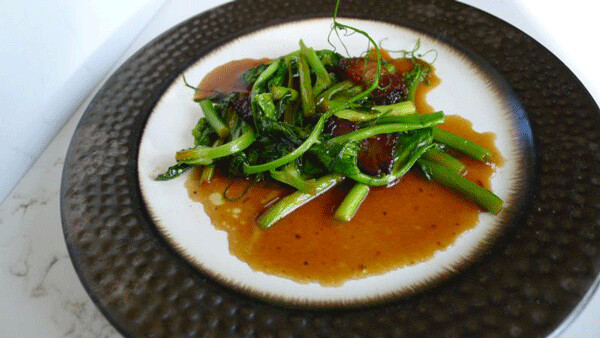News & Articles
Browse all content by date.


Garlic with pea shoots is a combination worth exploring. It’s hardly a secret, especially in Asia where pea greens are widely consumed. In many regions, peas are sown throughout the summer specifically for their greens, every week or so like like American farmers plant lettuce. A simple, heaping pile of pea greens in brown sauce is one of my favorite Chinese foods.
The culinary deconstructionists in the Cook’s Illustrated test kitchen, meanwhile, have broken down the savory nature of pea greens into “grassy,” “slightly bitter,” and “tastes like peas but not sweet.” They conclude this flavor is maximized in a pan with nothing more than garlic, salt and fat, and I have seen no evidence to the contrary.
Unless your local store has an extra-special produce section, you’ll only find pea shoots at the farmers market, or in your backyard. Before you harvest from your own pea patch, consider the trade-off between a mouthful of greenery today and a handful of peas tomorrow. The peas you already have in the ground, climbing their way up the trellis and probably showing some pale yellow flowers, perhaps dangling some little peas that your kids are waiting patiently to eat? You’d better let those gangly climbers live. But if they need to be thinned, eat the ones you pull. And you can always trim the shoots for a quick snack. The last six inches of a 3-foot plant are heavenly, and a little trim here and there won’t stop progress. Pruned plants will continue growing undaunted, sometimes with more vigor in response to the insult.
Elsewhere in the garden, the appearance of garlic flowers, aka scapes, marks the New Year according to the garlic calendar. After months of eating soft, sprouting garlic cloves, we can eat new garlic. The plant is alive and juicy and the flavor is sharp and spicy. Scapes are the first taste of the season’s new garlic crop.
Scapes, like pea greens, are curly. Each garlic flower wants to go around twice, before uncurling and standing up, eventually opening into a purple flower that looks like a celestial explosion.
My recipe for China Train Pea Greens is essentially pea greens added to my reconstructed recollection of a scape and pork dish I had on a train between Beijing and Ulaanbaatar.
China Train Pea Greens
Pea greens; 1 bunch, chopped or left whole
Garlic scapes; 1 handful, chopped into inch-long sections
Butter; 1-2 tablespoons
Olive oil; 1-2 tablespoons
Train Sauce*
Black pepper, salt, garlic powder; to taste
Bacon (optional, sort of); I keep my bacon frozen and cut it lengthwise off of one end, like slicing a sausage but through the ends of several pieces of frozen bacon at once. Most heavy knives have no problem because the fat prevents bacon from freezing rock hard. It doesn’t take a lot of these little bacon bits, sometimes called lardons, to make a difference in a meal. Use a slice of bacon’s worth of lardons for this dish.
*Train Sauce
Soy sauce; 4 tablespoons
Oyster sauce; 4 tablespoons
Fish sauce; 2 teaspoons
Sesame oil; 2 teaspoons
Lime juice; 3 tablespoons
Make train sauce by stirring together the ingredients. Cook the lardons (if using) patiently, until they are crispy, and then remove from pan. Add the oil, butter and scapes, turn the pan to medium, and wait for the glorious fragrance of fresh garlic in the pan to fill the room.
Add the pea sprouts; spread them around so they are evenly distributed, and wait until they flatten down, about 30 seconds. While still bright green, turn the pan to high and add the sauce. Bring to a boil and let the sauce boil 30 seconds, then stir it around and turn it off.
Serve with the carbohydrate of your choice, or unadulterated in all of its savory, tangy green garlicky glory.
When the scapes are gone, the new garlic season will still be young. The same dish can be prepared a few weeks later with new garlic, freshly dug with fleshy wrappers and pearly white cloves that turn translucent as they cook.
This dish can be made with other vegetables besides pea greens. It’s great with broccoli, for example. But some connoisseurs, understandably, want their pea greens, which, remember, can be seeded all summer long. Soak them overnight, and plant in any blank spot, preferably well-watered. If they get big, you aren’t eating enough pea greens.
And finally, a recipe created by my five year-old son Remy. Butter-fried pea green chips, which he enjoys preparing for breakfast and dinner and even midnight snack.
Pea Green Chips
With a heavy pan on lowest setting, melt two tablespoons salted butter. Lay pea shoots in the pan next to each other, taking up the whole pan without crowding them together too much; keep it all one layer. (Remy uses the leaves exclusively, carefully removing them and discarding the stems).
Keep the heat on the lowest setting. Listen to the pea greens sputter peacefully as their moisture cooks out. Let them cook a half-hour or more until crispy. Remy calls it good here, but predictably, I add some form of garlic: scapes, bulbs, even minced leaves if you have them. Let the the garlic cook, and gently mix it with the delicately crunchy pea greens.
Serve on a plate, next to a piece of toast.
| Tweet |


